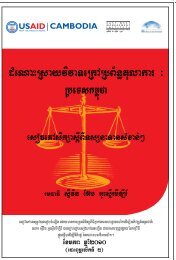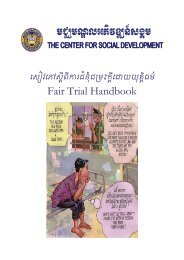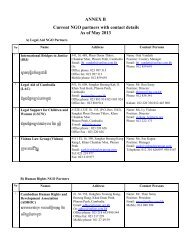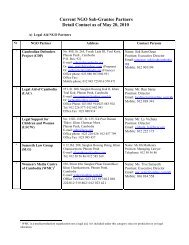6<strong>Legal</strong> <strong>Aid</strong> <strong>in</strong> <strong>Cambodia</strong>: <strong>Practices</strong>, <strong>Perceptions</strong> <strong>and</strong> <strong>Needs</strong>A Study based on a National Survey• The perceived coverage of legal aid services• Geographical <strong>and</strong> adm<strong>in</strong>istrative divisions of <strong>Cambodia</strong>• Locality of respondents, particularly with respect to both urban <strong>and</strong> rural clients <strong>and</strong>potential users of legal aid services.• Sectors of population• A clear common def<strong>in</strong>ition of poor classes• Ownership <strong>and</strong> authenticityPartially differ<strong>in</strong>g questionnaires were submitted to potential clients <strong>and</strong> legal aid providers(see Appendix B for the questionnaires). The ma<strong>in</strong> objectives of the study with respect to bothgroups were:• to analyze their perceptions of the formal <strong>and</strong> <strong>in</strong>formal justice systems• identify their perception of legal aid• evaluate their knowledge of the nature <strong>and</strong> availability of legal aid• determ<strong>in</strong>e their needs <strong>and</strong> expectations.Moreover, legal aid providers were also asked about:• the legal aid situation <strong>in</strong> their prov<strong>in</strong>ce• the ma<strong>in</strong> problems they face• their proposals to improve legal aid <strong>in</strong> <strong>Cambodia</strong>Follow<strong>in</strong>g open house workshops (chapter 2.4.1 below), face-to-face <strong>in</strong>terviews wereconducted <strong>in</strong> each of the five regions <strong>in</strong> April <strong>and</strong> May 2006. The total sample size was 650,consist<strong>in</strong>g of 500 potential clients (100 per region) <strong>and</strong> 150 legal aid providers (20 <strong>in</strong> PhnomPenh <strong>and</strong> 10 <strong>in</strong> each of the other 13 prov<strong>in</strong>ces <strong>in</strong>volved).The sample selection for potential clients was r<strong>and</strong>om, stratified by gender <strong>and</strong> <strong>in</strong>come group(those selected hav<strong>in</strong>g household <strong>in</strong>comes of less than $2,000 per year). The sample selectionfor legal aid providers was r<strong>and</strong>om.A sample profile of the potential clients is found <strong>in</strong> Appendix C. Gender distribution isbalanced, <strong>and</strong> reflects the population. The age groups are balanced, with 37% less than 35years old, reflect<strong>in</strong>g the profile of potential clients with low <strong>in</strong>comes. Educational levels arelow: 40% have never been to school or have not f<strong>in</strong>ished primary school, <strong>and</strong> 52% have aprimary school diploma, but have not f<strong>in</strong>ished secondary school. The family structure of therespondents shows that 52% of the sample have at least 3 children. Half the sample (mostlymales) consists of heads of households; 70% of the sample say that their family owns somel<strong>and</strong>; <strong>and</strong> 92% of the sample say they own their house. Interviewees describe the dom<strong>in</strong>antauthority <strong>in</strong> the community they live <strong>in</strong> as: the commune or sangkat (89%), the village chief(75%), <strong>and</strong> the police (63%). 63% of the sample lives <strong>in</strong> rural areas, 37% <strong>in</strong> urban orsuburban areas.2.4. METHODS OF DATA COLLECTIONThe ma<strong>in</strong> methods of data collection were structured <strong>in</strong>terviews, focus group discussions, key<strong>in</strong>formant <strong>in</strong>terviews, <strong>and</strong> documentary reviews. The use of ‘open house’ workshops (seebelow) was also helpful <strong>in</strong> the data collection exercise.
<strong>Legal</strong> <strong>Aid</strong> <strong>in</strong> <strong>Cambodia</strong>: <strong>Practices</strong>, <strong>Perceptions</strong> <strong>and</strong> <strong>Needs</strong> 7A Study based on a National Survey2.4.1 Open House WorkshopsThe first activity dur<strong>in</strong>g each survey visit was the hold<strong>in</strong>g of an open house workshop withrelevant stakeholders. The workshops were held <strong>in</strong> the period immediately before the surveyteam arrived <strong>in</strong> the area concerned. The workshops were organized, hosted <strong>and</strong> facilitated bythe Survey Management Team <strong>and</strong> the staff of the CLJR PMU.Those <strong>in</strong>vited to the open house workshops were key persons <strong>in</strong> the area work<strong>in</strong>g <strong>in</strong> thejudicial <strong>and</strong> legal sector. They <strong>in</strong>cluded prov<strong>in</strong>cial <strong>and</strong> district government officials, cadastralcommissioners, judges, prosecutors, lawyers, paralegals, prison staff, police, NGOrepresentatives, representatives of commune councils <strong>and</strong> representatives of communitygroups.The purpose of the open house workshops was twofold: first, to <strong>in</strong>troduce the survey <strong>and</strong> itsteam members to relevant stakeholders <strong>and</strong> prov<strong>in</strong>cial leaders. This served to ga<strong>in</strong> theirsupport. Second, to create an opportunity for the survey team to identify relevantrespondents, particularly NGO provid<strong>in</strong>g legal aid services.Open house workshops were held <strong>in</strong>:• Phnom Penh (for participants from Phnom Penh, Kampong Cham <strong>and</strong> Svay Rieng)• Battambang (for participants from Banteay Meanchay, Battambang <strong>and</strong> Pursat)• Siem Reap (for participants from Siem Reap <strong>and</strong> Odor Meanchay)• Kratie (for participants from Kratie, Rattanakiri <strong>and</strong> Mondalkiri)• Sihanoukville (for participants from Koh Kong, Sihanoukville, Kampot <strong>and</strong> Kep)2.4.2 Structured InterviewsThese were ma<strong>in</strong>ly done by survey researchers with legal aid providers identified prior to ordur<strong>in</strong>g the open house workshops. Structured <strong>in</strong>terviews were very helpful <strong>in</strong> clarify<strong>in</strong>g thenature of services provided, the target groups for such services, the staff<strong>in</strong>g arrangementsneeded to provide such services, etc. Members of the Survey Management Teamaccompanied researchers dur<strong>in</strong>g these structured <strong>in</strong>terviews.2.4.3 Focus Group DiscussionsFocus group discussions were carried out with persons from all focus regions of the survey(see Table 1 for a list<strong>in</strong>g of prov<strong>in</strong>ces the survey covered) with selected users <strong>and</strong> potentialusers of legal aid services, number<strong>in</strong>g around eight persons per focus group. The discussionswere helpful <strong>in</strong> provid<strong>in</strong>g <strong>in</strong>formation on needs <strong>and</strong> gaps <strong>in</strong> exist<strong>in</strong>g services. Focus groupdiscussions with commune councilors gave a clear picture of problems need<strong>in</strong>g to beaddressed. Steps were taken to carry out separate focus group discussions with male <strong>and</strong>female discussants, mak<strong>in</strong>g it easier to analyze gender variations <strong>in</strong> legal aid needs.Participation <strong>in</strong> the focus group discussions of judges <strong>and</strong> prosecutors, prov<strong>in</strong>cial <strong>and</strong> districtgovernment officials, prison officers, police, <strong>and</strong> NGO representatives gave the survey theopportunity to arrange <strong>in</strong>dividual <strong>in</strong>terviews or further focus groups discussions with a widerange of respondents.The focus group discussions were conducted by survey researchers with support from theSurvey Management Team <strong>and</strong> staff of the CLJR PMU.
- Page 1 and 2: Council for Legal and Judicial Refo
- Page 5: Legal Aid in Cambodia: Practices, P
- Page 8 and 9: iiLegal Aid in Cambodia: Practices,
- Page 10 and 11: ivLegal Aid in Cambodia: Practices,
- Page 12 and 13: 2Legal Aid in Cambodia: Practices,
- Page 14 and 15: 4Legal Aid in Cambodia: Practices,
- Page 18 and 19: 8Legal Aid in Cambodia: Practices,
- Page 20 and 21: 10Legal Aid in Cambodia: Practices,
- Page 22 and 23: 12Legal Aid in Cambodia: Practices,
- Page 24 and 25: 14Legal Aid in Cambodia: Practices,
- Page 26 and 27: 16Legal Aid in Cambodia: Practices,
- Page 28 and 29: 18Legal Aid in Cambodia: Practices,
- Page 30 and 31: 20Legal Aid in Cambodia: Practices,
- Page 32 and 33: 22Legal Aid in Cambodia: Practices,
- Page 34 and 35: 24Legal Aid in Cambodia: Practices,
- Page 36 and 37: 26Legal Aid in Cambodia: Practices,
- Page 38 and 39: 28Legal Aid in Cambodia: Practices,
- Page 40 and 41: 30 Legal Aid in Cambodia: Practices
- Page 42 and 43: 32 Legal Aid in Cambodia: Practices
- Page 44 and 45: 34 Legal Aid in Cambodia: Practices
- Page 47 and 48: Legal Aid in Cambodia: Practices, P
- Page 49 and 50: Legal Aid in Cambodia: Practices, P
- Page 51 and 52: Legal Aid in Cambodia: Practices, P
- Page 53 and 54: Legal Aid in Cambodia: Practices, P
- Page 55 and 56: Legal Aid in Cambodia: Practices, P
- Page 57 and 58: Legal Aid in Cambodia: Practices, P
- Page 59 and 60: Legal Aid in Cambodia: Practices, P
- Page 61 and 62: Legal Aid in Cambodia: Practices, P
- Page 63 and 64: Legal Aid in Cambodia: Practices, P
- Page 65 and 66: Legal Aid in Cambodia: Practices, P
- Page 67 and 68:
Legal Aid in Cambodia: Practices, P
- Page 69 and 70:
Legal Aid in Cambodia: Practices, P
- Page 71:
Legal Aid in Cambodia: Practices, P









